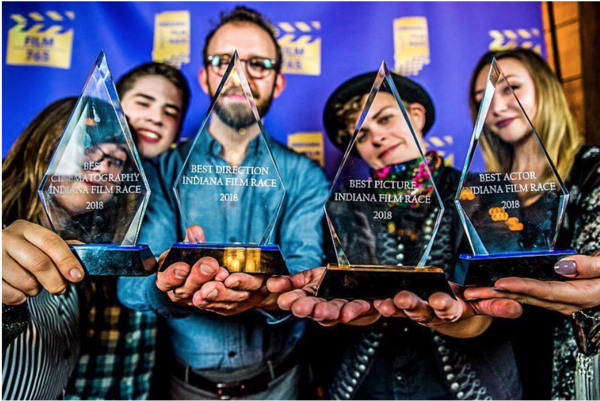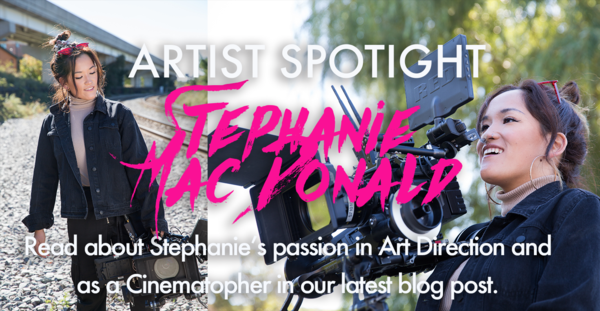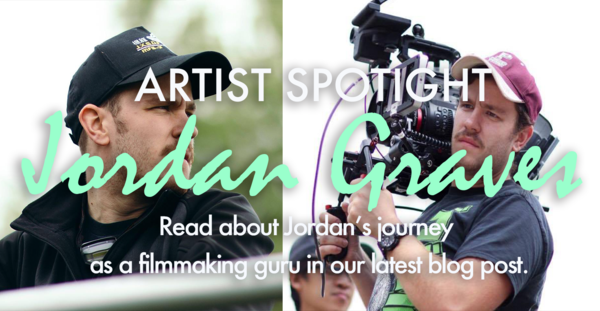How we won the Indiana Film Race!
 Team Gold received four awards for their film Golden Voices in the 2018 Indiana Film Race. Photo by: Rick Lang (facebook.com/rlangphoto)
Team Gold received four awards for their film Golden Voices in the 2018 Indiana Film Race. Photo by: Rick Lang (facebook.com/rlangphoto)
If you want a shiny new paperweight like one of these for your office you’ve got to work for it. The day this photo was taken we were shocked and amazed. Having successfully traversed the challenges of the first ever Indiana Film Race, we began to reflect on all that had happened during the short ten weeks of the project. We thought that if we could identify key decisions and processes that allowed us to produce our award-winning film, hone those tactics and even replicate them, we’d be sure to knock the next one out of the park as well.
Here you’ll find this list of tips which led to our success which we believe are universal across all genres and scales of indie filmmaking. It’s my hope that these tips will bring you success, too. So if you want to develop thoughtful processes throughout all aspects of your production, make awesome movies, and have fun doing it, keep reading.
5 Tips for a Successful Film Production
1. Know Your Personnel
Forming a strong team is the first priority because nothing happens without your key collaborators. As team leader of the race, I could only choose four others to join the quest for 10k in the crossroads of America.

We filmed our pitch video together and after we got into the race, we held auditions. We found an actress who was willing not only to brave the project with us but contributed significantly to forming the character of Radha. Each individual brought something special to the table: skills, knowledge, and ways of thinking. We had never worked together as a team before, but we shared a common vision for our story and its message. I took stock of our strengths and weaknesses as a team and then it was time to begin the process of creative development.
2. Pre-Pro Like a Boss
Early ideas for our film were imagined around a campfire. We spent every night of our scouting missions sharing a campsite and dreaming up ideas for our not-yet-written film. This prepared us for life on the road, got us familiar with our locations and their representatives, and it gave us a chance to share more about each other and our ideas. Our travels lit the fuse for the creative development of our story.

As the script was fleshing out, so too were the spreadsheets. Staying on top of these workflows and creating a realistic schedule for our pre-production needs helped us to stay accountable to our deadlines and make sure that every member had enough time to do their part. On the Indiana Film Race, especially, we had very little time to write, develop, and shoot a film to completion. Most processes were happening in tandem so communication, research, and information sharing are critical. So too, was delegating. Development and pre-production would form the processes that we created for collaboration. It was during this time that we set clear expectations for ourselves and the project as a whole.
3. Choose Your Gear Wisely

Run-and-gun is a style of production, not cinematography. Cramming five of us into an RV with our personal things as well as props, equipment, and wardrobe meant that everyone would have to sacrifice some level of comfort. Knowing this, our goal was to build the smallest possible camera package that would maximize production value. Here are some tips on choosing equipment that will save you time and space. Today’s cinema product market is full of compact options. Sticking to lightweight gear allowed us to set up and move quickly between locations. A portable slider, for example, is compact enough to move around a set without disassembling, and it allowed us to achieve stabilization and movement comparable to a larger dolly setup. We often built the slider at the start of each day and it rarely came off.
The most important part of choosing the right camera package is suiting the package to your specific needs. We could have easily chosen a larger, “better” camera or a larger lighting kit. But we chose the tools that would get the job done without inhibiting the production process. If your package is too much to manage you’ll eat time at load in/out and between changes in a shot set up. What’s worse is if you rent gear or a camera you haven’t used before or have no idea how to troubleshoot. Try staying on schedule!
4. Communication is Key
No film is created in a vacuum. You need a team to pull off the feat of movie magic! Do not overlook the importance of communication to form an understanding of your film’s concepts and story structure. If you’re in a position of leadership, take it a step further by working through all the different ways your team will communicate. A film crew, like any team, should function as a well-oiled machine.
There were moments when we knew that each member would need to flex in their role. Because we had a skeleton crew, no member was exempt from load-in and set up. These expectations were made clear from the beginning, and everyone was willing to do whatever it took to get the shot and move efficiently between locations. Zack Sievers, who was our Production Manager on the race, puts it simply as “be the glue.” The essence of this statement is to put in the work to form understanding among your team and to help someone who may need it. This resulted in a happy crew that stayed hungry and ambitious throughout the whole race.
If you had to take one thing away from this article it’s this: emphasize communication and transparency from the start. Foster synergy and consistency of collaboration that can flourish. This pattern will become the structure that carries you and your team through all phases of production.
5. Have a Policy of Flexibility
There is an aphorism that when you venture to produce a movie, you’re not making one but three films: the film you write, the one you shoot, and the one you edit. There’s just one way to work through these shifting phases and ensure the success of your project: adapt. Having the flexibility to adapt to daily pressures and challenges is a rule. All the work you did in pre-production is useful to you here and now. Know the schedule and know your script backward and forwards. Know what needs to get done and how to delegate. Above all else, know your limits. Production days are long and wear on us all. If you see someone who needs a break, be the glue and ask how you can help.
The goal is to anticipate challenges and head off issues by having a plan. Yet no matter how much you plan, expect to utilize the tactics and processes you learned here to turn any surprise into something you can work with. We had to work around customers on location in businesses that were open. Our script and shot list were changing minutes before the picture was up. Between time constraints, technical issues, and miscommunications which, trust me, WILL happen, our team saw its fair share of choppy waters. Creative solutions were necessary to navigate safely to shore and come out victorious.
**BONUS TIP!**
As far as traveling productions are concerned there are some precautions you simply cannot afford to skip.
Prepare for intermittent cell service and limited access to the internet. You will need reliable communication tools to replace texting and email so definitely snatch up a set of walkies for you and your team. If you have scouted properly you should know where the WiFi access points are along your route. Print and bring hard copies of vital production documents and insurance papers. Oh, and definitely bring a map!
Above all else, take time to care for yourself and each other. Realize that you will need to spend a couple days adapting to conditions far removed from your daily routine.
Team Gold


Zack Sievers
Writer/Creative Developer - “Having a more fluid practice of writing and editing allowed us to meet challenges that arose over the course of the competition, such as time constraints. It also allowed us to incorporate ideas that occurred to us on the spot, in the moment of the shoot on location.
 Melissa Schlesinger
Melissa Schlesinger
Art Director/Audio -“Be there. Be in the moment. Remember the goals you set out back in pre-pro. Bring them to the set and Get. It. Done. Help your team however you can, pay attention, ask questions, and figure it out. Respect the vision, respect the project, respect your team, & respect yourself. No matter what the production’s goals and visions are if you approach a project with curiosity, creativity, and empathy for your team, you’re bound to make something great.”

Blog Post Written by Grace Pisula


 Team Gold received four awards for their film Golden Voices in the 2018 Indiana Film Race.
Team Gold received four awards for their film Golden Voices in the 2018 Indiana Film Race. 
